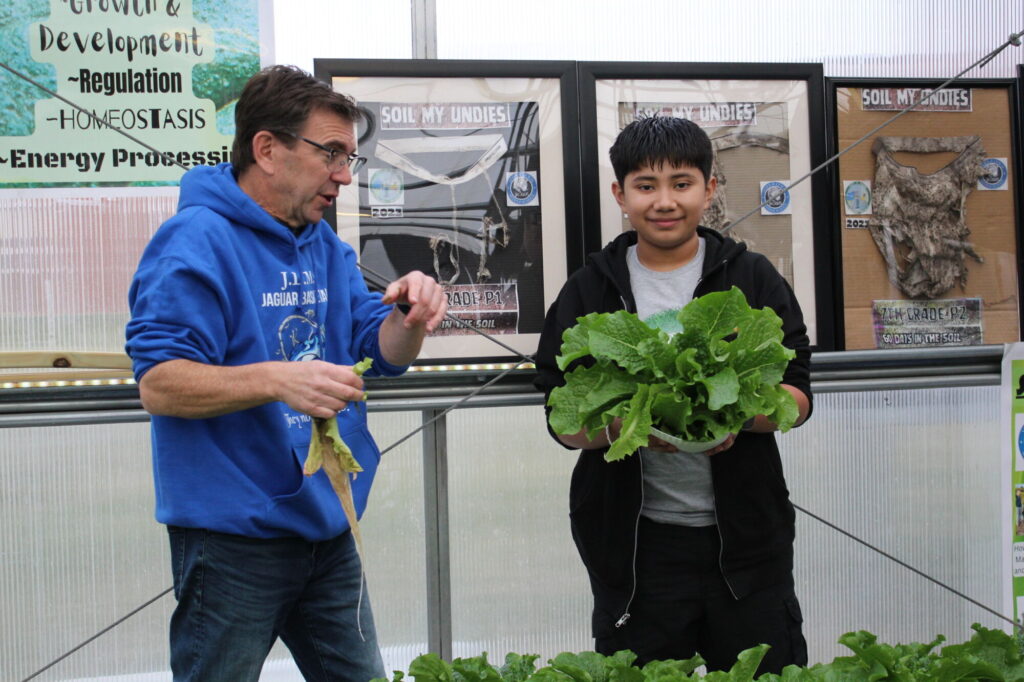“Food and the environment are interconnected” is an important concept for students to understand. Students who demonstrate an understanding of this standard can define seasonality, explain its relation to food and distinguish how natural and built environments can affect the seasonality of foods.
This Standard Means
- Food (in all its forms) is an integral part of an ecosystem.
- All living organisms depend on one another for energy.
- Fruits and vegetables have optimal growing seasons, also known as seasonality.
- Some foods are warm weather crops and some foods are cold weather crops.
- The availability of food is dependent on different environmental factors.
- Seasonality impacts our food systems, and natural and built environments both affect the seasonality of foods.
- Different foods are cultivated, produced, and transported all over the world.
- Humans impact and affect the environment as well as food systems. We must learn about being responsible stewards of our resources.
FES 3 In Action
 “The [Agriculture Education & Advocacy] lessons are extremely culturally relevant because [students] all eat and many of them don’t know where their food is coming from. They have aha moments learning that agriculture isn’t just about farming.”
“The [Agriculture Education & Advocacy] lessons are extremely culturally relevant because [students] all eat and many of them don’t know where their food is coming from. They have aha moments learning that agriculture isn’t just about farming.”
-Pilot Light Educator, 2024
How to Bring FES 3 to Your Students
Try these examples of real-world community experiences with your students aged K-12 to help them understand the importance of FES 3 in their daily lives!
- Germinate seeds under different conditions and analyze the success rate of the seeds.
- Examine pictures of a grocery store produce section taken at different times of year to observe changes in produce availability and origins, and compare these changes to an anchor text about seasonality. Alternatively, visit a local store or market to observe the produce section at different times of year.
- Visit a farm or have a farmer visit and discuss what is meant by ”growing season.”
- Encourage a visit from a chef or industry professional that works in a farm-to-table restaurant.
- Analyze and monitor the countries of origin for foods throughout the year by visiting grocery stores, farmers’ markets, or online retailers to observe when changes in origin occur.
- Develop a plan to consume seasonal foods by planting and using crops in the school garden to create meals.
- Use a school garden, community garden, hydroponics tower or classroom window boxes to plant seasonal crops, and then work to create meals/snacks using the produce grown.
- Work with local officials to create or help maintain and increase awareness of farmers markets and community gardens.
- Interview scientists, including environmental scientists, about food-related findings within their particular domain.
- Grow and save seeds from plants that thrive in their local climate for use in a school or community garden.
- Meet with school food service professionals to learn how local/seasonal foods are used in the school food program.
- Visit a farm and/or interview farmers about the process and environmental impacts of crop rotation and other farming practices.
- Connect with a food conglomerate (e.g. Kraft or others) to interview executives about how the company responds to shifts in supply and demand due to climate change.
- Work with community members and food awareness coalitions to analyze community food access and availability.
Grade-Specific Competencies
- I can name the seasons.
- I can talk about what times of year food can grow.
- I want to know about the different parts of plants we eat.
Play-Based Activities
- Dramatic play: incorporate items found on a farm; encourage the play of planting, harvesting, packaging, selling food
- Change the play food availability in the farmer’s market/grocery store/restaurant according to each season
- Observe, sort, describe and classify photos through the seasons
- Take nature walks at different times throughout the year to notice and observe seasonal change
- Create sensory bins to match seasons (fall leaves, apples, corn..)
- Plant quick-growing seeds and expose them to different conditions
- Sort the play fruits and vegetables in dramatic play according to the part of plant that is eaten
- Bring in different types of produce by season and explore them
- Look at real foods in snack/lunch to determine which part of a plant kids are eating (tomato = fruit, carrot = root, lettuce = leaves)
- Pretend to work in a restaurant and make a salad as a class to explore parts of plants that are eaten
Grade-Specific Competencies
- Explain how seasonality affects the food of a particular culture.
- Distinguish food options by climate and season.
- Distinguish between the natural and built environments.
Grade-Specific Competencies
- I can talk about the environmental impact of food production, overproduction, and food waste.
- I want to know about the energy used in producing, preserving, and transporting food.
Grade-Specific Competencies
- I want to know about the impact of modern food practices on sustainability.
- I can explain the interdependence of food supply and demand.
- I understand that climate-based food availability and patterns of consumption shape the food of a particular culture.
Grade-Specific Competencies
- I want to know more about the impact of climate change on food availability.
- I am aware of the environmental impacts of different types of agricultural practices (e.g., crop rotation, factory farms, overfishing, GMOs, pesticides, land stewardship) on the larger food system.
- I want to know how food justice can promote access in restricted areas (e.g. communities experiencing food apartheid/insecurity).
- I can talk about the environmental impact of global food demands regardless of climate and season, and how the food supply responds to shifting demands.

